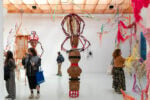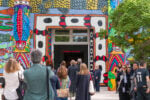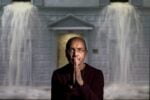Reinhard Mucha
.jpg)
La Galleria Lia Rumma è lieta di presentare la mostra personale Schneller werden ohne Zeitverlust (Accelerare senza perdere tempo) di Reinhard Mucha.
Comunicato stampa
La Galleria Lia Rumma è lieta di presentare la mostra personale Schneller werden ohne Zeitverlust (Accelerare senza perdere tempo) di Reinhard Mucha che inaugura il 24 novembre 2016 alle ore 18.30 a Milano.
La mostra si sviluppa in stretta relazione con la prima personale dell’artista, Mutterseelenallein (Solitudine), inaugurata il 29 giugno 1989 alla Galleria Lia Rumma di Napoli: un evento che ha segnato la lunga relazione tra l'artista e la Galleria. Erano gli anni delle importanti personali di Mucha presso la Kunsthalle Basel (Nordausgang) e la Kunsthalle Bern (Kasse beim Fahrer) 1987, della mostra Gladbeck, realizzata nel 1986 presso il Musée National d’Art Moderne, Centre Georges Pompidou di Parigi e di quella presentata due anni prima al Württembergischer Kunstverein di Stoccarda.
Mutterseelenallein – All Alone (The seats for attendants and visitors at the “Große Düsseldorfer Kunstausstellung” shot at the Kunstpalast Ehrenhof in Düsseldorf on December 30, 1979) presentata in quell’occasione, è un vero e proprio intervento museale, nella forma di sedici teche montate a muro composte da alluminio, vetro float, vetro retrodipinto a smalto, feltro, 15 fotografie in bianco e nero su carta baryta e legno che esaltano e trasformano lo spazio della Galleria di Napoli in un luogo di melanconica eleganza e al cui centro, tranne in una, si vede la fotografia in bianco e nero di una sedia vuota. Tutte diverse, le sedie sono quelle usate da custodi o stanchi visitatori durante la mostra Große Düsseldorfer Kunstausstellung, tenutasi una decina di anni prima a Düsseldorf. Tematizzando il concetto di “mostra d’arte”, l’opera evocava una sensazione di vuoto e di solitudine, suggerendo allo stesso tempo la poesia dell’attesa e simboleggiando la sobria specificità di ogni singola sedia.
La storia di questo lavoro è un insieme di eventi, di attimi colti, di coincidenze poetiche accadute in maniera probabilmente fortuita, di un destino segnato, che da molti anni lega l’artista all’Italia.
Nata per gli spazi della Galleria Lia Rumma di Napoli, l’opera rimase per nove anni al Museum für Modern Kunst di Francoforte (M.). Vicissitudini ormai celate nel tempo, fanno sì che il lavoro compia un nuovo viaggio verso l’Italia dove riapproda a partire dal 2009, per entrare a fare parte della collezione permanente del Castello di Rivoli Museo d'Arte Contemporanea.
Schneller werden ohne Zeitverlust è l’ultimo episodio di un viaggio lungo quasi tre decenni, la fase conclusiva di un percorso che somiglia a un “ritorno a casa”.
Reinhard Mucha presenta questo nuovo progetto espositivo al cui centro si colloca “Die Verwandlung” (“La metamorfosi”) il modellino-scultura della storica installazione Mutterseelenallein, al cui interno si condensa la storia dell’opera, visibile nelle stesse immagini trasmesse dai monitor che raccontano le inquadrature e le riprese dell’allestimento dell’opera al museo di Francoforte. Da questo nucleo centrale si dipana tutto il percorso espositivo che dialoga con l'ex area industriale di Milano in cui è stato costruito il nuovo edificio della Galleria. I presupposti teorici e concettuali che sono alla base della ricerca artistica di Reinhard Mucha hanno nuovamente la possibilità di legarsi in maniera reale e diretta con l’architettura all’interno della quale la mostra prende forma e con il paesaggio industriale circostante. In Insel der Seligen (Isola dei beati) Mucha gioca con questo contesto e provocatoriamente ricrea l’immagine di un tetto di tegole antiche che giacciono a terra, meticolosamente distribuite su un letto di detriti. Il senso del dramma, il ruolo centrale della memoria, la sua riflessione profonda e critica nei confronti della realtà urbana si esprimono in maniera corale in questa installazione.
Non è un caso che nell’opera The Wirtschaftswunder – To the People of Pittsburgh III (Il miracolo economico – Per i cittadini di Pittsburgh III), esposta in mostra, si ritrovano anche oggetti industriali prodotti nella fabbrica che era ospitata nello stesso luogo dove l’artista ha ancora il suo studio, in una delle ex aree dell’industria pesante di Düsseldorf. In mostra è presente anche il film inedito Hidden Tracks e una serie di nuove opere realizzate dall’artista nel corso degli anni.
Un percorso espositivo completo ed esaustivo che testimonia la complessità e la profondità del lavoro di uno dei maggiori artisti europei contemporanei. Il suo lavoro prende in prestito riferimenti diretti e indiretti dalla Minimal Art e dal Postminimalismo così come dal mondo dell’Architettura e del Design, facendo riferimento al discorso critico sulle istituzioni museali e alle implicazioni che ne derivano, combinandoli alla dimensione intima e privata, propria dell’uomo, ad un forte senso di caducità, di transitorietà e di drammaticità. Reinhard Mucha crea opere dalla presenza estetica e formale unica e inconfondibile. Grandi “contenitori” al cui interno presenziano immobili porzioni di realtà e di quotidianità. Attimi di mondo che attraverso la loro precisione, estraneità e impersonalità trasmettono tutte le sensazioni di un “tempo alieno”, costantemente in fase di costruzione e decostruzione.
Reinhard Mucha è nato a Düsseldorf, Germania, nel 1950, dove ha studiato con Klaus Rinke all’Accademia d’Arte. E’ qui che ha sviluppato il suo complesso linguaggio artistico che si è poi espresso pienamente all’interno di installazioni fondamentali, in Europa e negli Stati Uniti, tra gli anni Ottanta e gli anni Novanta. Tra le più significative ricordiamo: Gladbeck, al Centre Georges Pompidou di Parigi, nel 1986; Mutterseelenallein, esposta tra il 1991 e il 1999 al Museum für Moderne Kunst a Francoforte, e dal 2009 al Castello di Rivoli Museo d’Arte Contemporanea di Torino; Das Deutschlandgerät, alla 44ma Biennale d’Arte di Venezia del 1990; Wartesaal a documenta X, Kassel, nel 1997 e Stockholmer Raum-Für Rafael Moneo al Moderna Museet, di Stoccolma, nel 1998. Nel corso dalla produzione artistica degli ultimi quattro decenni, Reinhard Mucha ha toccato temi legati all’identità collettiva, alla memoria, al nazionalismo, alla psicologia dell’architettura e del potere, al museo in quanto luogo dove si crea la storia, attraverso una narrativa che fonde paesaggi industriali, storici e politici allo stesso tempo. Il suo lavoro si confronta costantemente con diversi tipi di dualità: temporalità e permanenza, narrativa intima e storia nazionale, progresso e stasi, collegamento e isolamento. Il lavoro di Reinhard Mucha è incluso in numerose istituzioni pubbliche, tra cui: il Museum of Modern Art di New York, la Tate Modern di Londra, la Nationalgalerie di Berlino, il Centre Georges Pompidou di Parigi, l’Art Institute of Chicago, il San Francisco Museum of Modern Art, il Castello di Rivoli - Museo d’Arte Contemporanea di Torino, l’Hirshhorn Museum and Sculpture Garden di Washington D.C., il Walker Art Center di Minneapolis e il Museo Reina Sofia di Madrid. Reinhard Mucha vive a Düsseldorf.
***
Lia Rumma Gallery is pleased to present the solo exhibition Schneller werden ohne Zeitverlust (Getting Faster without Time Loss) by Reinhard Mucha, which opens on 24 November 2016 at 6.30 p.m. in Milan.
The current show follows Mutterseelenallein, Mucha's exhibition opened on 29 June 1989 in Naples: it was a major event destined to leave its mark on the longlasting relationship between the Gallery and the artist. Those were the years of Mucha's remarkable solo exhibitions at the Kunsthalle Basel (Nordausgang) and Kunsthalle Bern (Kasse beim Fahrer) 1987, of Gladbeck, the show put on in 1986 at the Musée National d’Art Moderne, Centre Georges Pompidou, in Paris and the one shown two years previously at the Württembergischer Kunstverein in Stuttgart.
Mutterseelenallein – All Alone (The seats for attendants and visitors at the “Große Düsseldorfer Kunstausstellung” shot at the Kunstpalast Ehrenhof in Düsseldorf on December 30, 1979) is a distinctive museum piece in the form of sixteen wall-mounted display cases made of aluminum, float glass, enamel painted on reverse of glass, felt, 15 black-and-white photographs on baryta paper and wood, accentuating and transforming the gallery space in Naples into a site of melancholic elegance. At the centre of each case – except for one – was a black-and-white photograph of an empty chair. All different, the chairs were those that had been used by gallery attendants or tired visitors during the “Große Düsseldorfer Kunstausstellung” exhibition, held ten years previously in Düsseldorf. By examining the concept of the “art exhibition”, the work brought about a feeling of emptiness and loneliness, while also suggesting the poetry of waiting and symbolising the individual character of each of those inconspicuous chairs.
The history of this work is a series of events and moments captured and of poetic coincidences that occurred probably quite by chance. It is the story of an inescapable destiny that for many years has bound the artist to Italy.
Created for the spaces of Lia Rumma Gallery in Naples, the work remained for no less than nine years at the Museum für Moderne Kunst in Frankfurt (M.). Events now lost in time meant that the work would eventually embark on a new journey, to Italy, where it landed once again in 2009 and where it became part of the permanent collection of Castello di Rivoli Museo d'Arte Contemporanea.
Schneller werden ohne Zeitverlust is the latest episode in a long voyage that has been going on for nearly three decades, and the final step in a process that has all the appearance of a homecoming.
Reinhard Mucha is presenting this new exhibition project with at its centre “Die Verwandlung” (“The Metamorphosis”) a model sculpture of the historic Mutterseelenallein installation in Frankurt. A piece in which the history of the work is condensed and where the incorporated video monitors repropose the images of the installation at the museum in Frankfurt.
The entire exhibition spreads out from this nucleus, entering into a dialogue with a former industrial area of Milan in which the new gallery building has been constructed. It all fits in here, for the theoretical and conceptual premises at the heart of Reinhard Mucha’s artistic research are once again able to bind effectively and directly with the architecture in which the exhibition takes shape as well as with the urban landscape surrounding.
In Insel der Seligen (Island of the Blessed), Mucha plays with this context and provocatively shows us a roof of ancient tiles as an image lying on the ground meticulously spread out on a bed of demolition rubble. The sense of drama and the key role of memory, its profound reflections and its criticism on urban reality are all chorally expressed in this profane room installation.
It is no coincidence that in The Wirtschaftswunder - To the People of Pittsburgh III, included in the exhibition, you can see also industrial objects produced inside the factory that was housed in the premises where the artist still has his studio today in one of the former areas of heavy industries in Düsseldorf.
The exhibition also includes the film Hidden Tracks never previously shown and some more new works that the artist has created over the years. This complete, comprehensive exhibition illustrates the complexity and depth of the work of one of Europe’s greatest contemporary artists. His work borrows direct and indirect references from Minimal Art and Postminimalism as well as from the world of Architecture and Design and refers to the critical discurse on museums praxis and its implicated issues. Combining them in an intimate, personal dimension, on a human scale, and with a powerful sense of transience, Reinhard Mucha creates works with a unique, unmistakable aesthetic and formal presence. These “containers” preside over the motionless portions of reality and everyday life within them. Through their preciseness, alienation and impersonality, these moments of the world convey all the sensations of an alien time, in a constant state construction and deconstruction.
Reinhard Mucha was born in Düsseldorf, Germany in 1950 and studied with Klaus Rinke at the Düsseldorf Academy of Art, where he began to develop his highly complex artistic language that would find full form in a number of seminal installations in Europe and in the USA throughout the 1980s and 1990s. These include Gladbeck at the Centre Georges Pompidou, Paris in 1986; Mutterseelenallein at the Museum für Moderne Kunst, Frankfurt (M). in 1991-1999, and since 2009 as permanent installation at Castello di Rivoli Museo d’Arte Contemporanea, Torino; Das Deutschlandgerät at the 44th Venice Biennale in 1990; Wartesaal at Documenta X, Kassel in 1997; and Stockholmer Raum - Für Rafael Moneo at the Moderna Museet, Stockholm in 1998. Throughout Mucha’s artistic production of the past four decades run themes of collective identity, memory, nationalism, the psychology of architecture and power, the museum as the locus for the creation of history, and the merging of industrial, historical and political landscapes. His complex work penetrates several dualities: connectivity and isolation, temporality and permanence, intimate narrative and national history; progress and stasis. Reinhard Mucha’s work is included in the permanent collections of numerous international public institutions, including the Museum of Modern Art, New York; Tate Modern, London; Nationalgalerie, Berlin; Centre Georges Pompidou, Paris; Art Institute of Chicago; San Francisco Museum of Modern Art; Castello di Rivoli Museo d’Arte Contemporanea, Turin, the Hirshhorn Museum and Sculpture Garden, Washington D.C., The Walker Art Center, Minneapolis and Reina Sofia Museum, Madrid. Reinhard Mucha currently resides in Düsseldorf.



